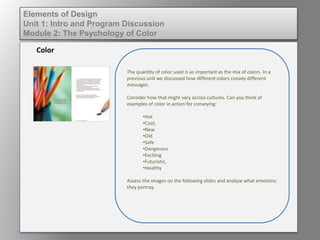Elem of design unit 1 module 2 psychology of color
•Transferir como PPTX, PDF•
0 gostou•117 visualizações
Denunciar
Compartilhar
Denunciar
Compartilhar

Recomendados
Recomendados
Mais conteúdo relacionado
Semelhante a Elem of design unit 1 module 2 psychology of color
Semelhante a Elem of design unit 1 module 2 psychology of color (18)
Elem of design unit 1 module 2 psychology of color 

Elem of design unit 1 module 2 psychology of color
World View Chart AssignmentsDue Weeks 2 through 10 and worth 35 .docx

World View Chart AssignmentsDue Weeks 2 through 10 and worth 35 .docx
Introduction to the Module - Fundamentals of Psychology Lecture 1

Introduction to the Module - Fundamentals of Psychology Lecture 1
A world view is a fundamental or basic orientation of thinking – lik.docx

A world view is a fundamental or basic orientation of thinking – lik.docx
Module 2 - HomeDIMENSIONS OF CULTUREModular Learning Outcomes.docx

Module 2 - HomeDIMENSIONS OF CULTUREModular Learning Outcomes.docx
Mais de kateridrex
Mais de kateridrex (20)
Dig imag unit 11 module 4 creating slices in an image (2)

Dig imag unit 11 module 4 creating slices in an image (2)
Dig imag unit 11 module 4(2) creating slices in an image

Dig imag unit 11 module 4(2) creating slices in an image
Dig imag unit 11 module 4 creating slices in an image

Dig imag unit 11 module 4 creating slices in an image
Dig imag unit 11 module 1 understanding web graphics

Dig imag unit 11 module 1 understanding web graphics
Dig imag unit 9 module 1 working with the pen tool

Dig imag unit 9 module 1 working with the pen tool
Dig imag unit 8 module 2 creating and saving alpha channels

Dig imag unit 8 module 2 creating and saving alpha channels
Dig imag unit 7 module 1 understanding and implementing filters

Dig imag unit 7 module 1 understanding and implementing filters
Dig imag unit 5 module 2 using the various painting tools

Dig imag unit 5 module 2 using the various painting tools
Dig imag unit 5 module 1 learning about brush types and properties

Dig imag unit 5 module 1 learning about brush types and properties
Dig imag unit 4 module 1 learning about type fonts and properties[2]![Dig imag unit 4 module 1 learning about type fonts and properties[2]](data:image/gif;base64,R0lGODlhAQABAIAAAAAAAP///yH5BAEAAAAALAAAAAABAAEAAAIBRAA7)
![Dig imag unit 4 module 1 learning about type fonts and properties[2]](data:image/gif;base64,R0lGODlhAQABAIAAAAAAAP///yH5BAEAAAAALAAAAAABAAEAAAIBRAA7)
Dig imag unit 4 module 1 learning about type fonts and properties[2]
Elem of design unit 1 module 2 psychology of color
- 1. The quantity of color used is as important as the mix of colors. In a previous unit we discussed how different colors convey different messages. Consider how that might vary across cultures. Can you think of examples of color in action for conveying: •Hot •Cool, •New •Old •Safe •Dangerous •Exciting •Futuristic, •Healthy Assess the images on the following slides and analyze what emotions they portray. Color Elements of Design Unit 1: Intro and Program Discussion Module 2: The Psychology of Color
- 2. Color Elements of Design Unit 1: Intro and Program Discussion Module 2: The Psychology of Color
- 3. Color Elements of Design Unit 1: Intro and Program Discussion Module 2: The Psychology of Color
- 4. Color Elements of Design Unit 1: Intro and Program Discussion Module 2: The Psychology of Color
- 5. Color Elements of Design Unit 1: Intro and Program Discussion Module 2: The Psychology of Color
- 6. Color Elements of Design Unit 1: Intro and Program Discussion Module 2: The Psychology of Color
- 7. Color Elements of Design Unit 1: Intro and Program Discussion Module 2: The Psychology of Color
- 8. Color Elements of Design Unit 1: Intro and Program Discussion Module 2: The Psychology of Color
- 9. Used in the creation of the Parthenon in Greece, the Golden Ratio is considered to contain proportional harmony in both aesthetic beauty & structural integrity. To determine the Golden Ratio: divide a rectangle into two parts so that the length of the longer section divided by the length of the smaller section is also equal to the whole length divided by the longer section. Color Elements of Design Unit 1: Intro and Program Discussion Module 2: The Psychology of Color